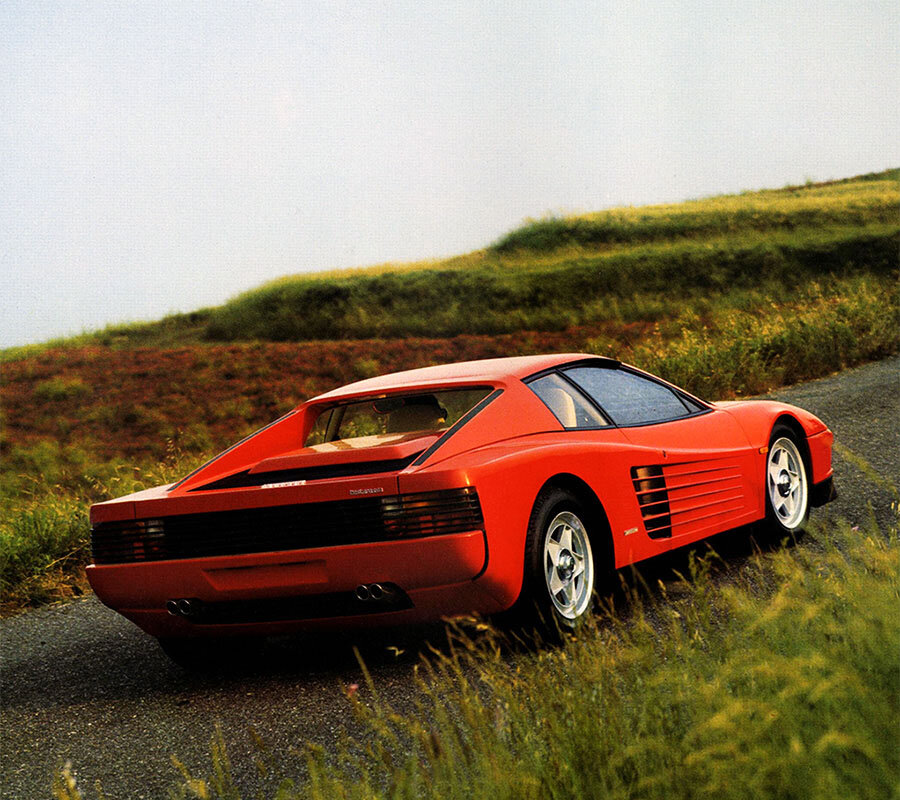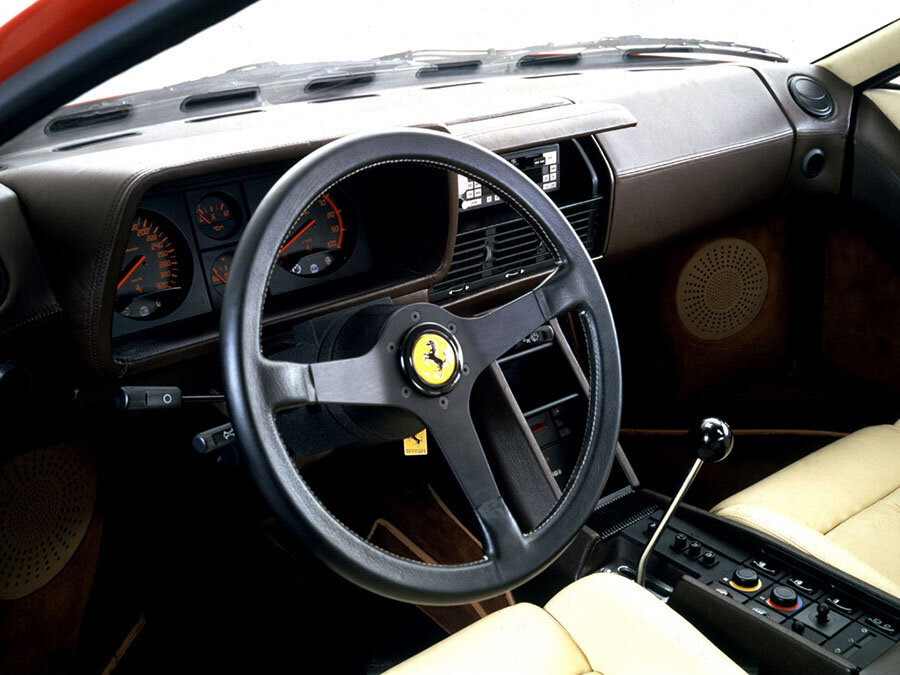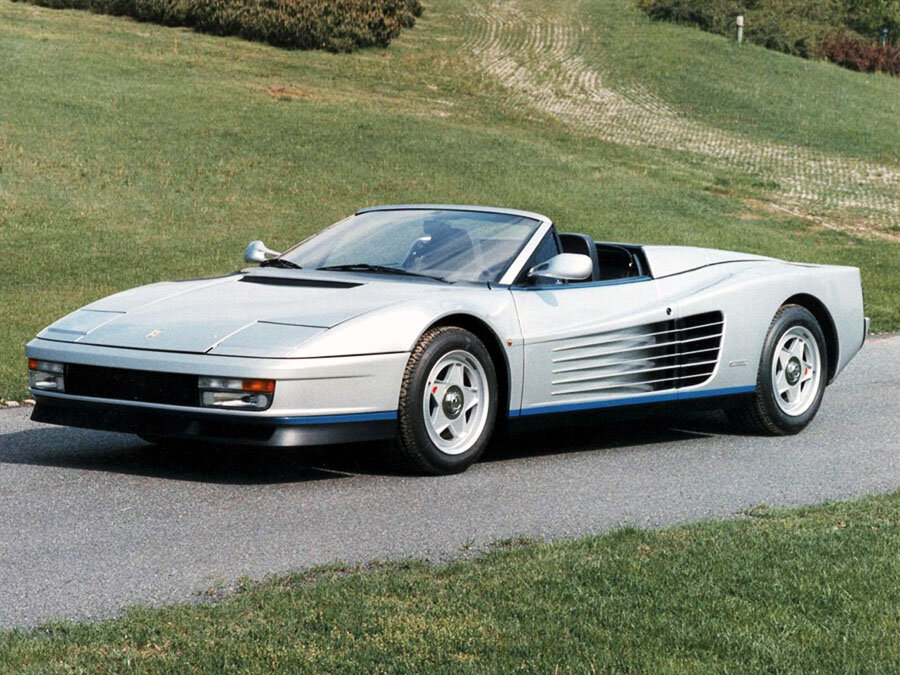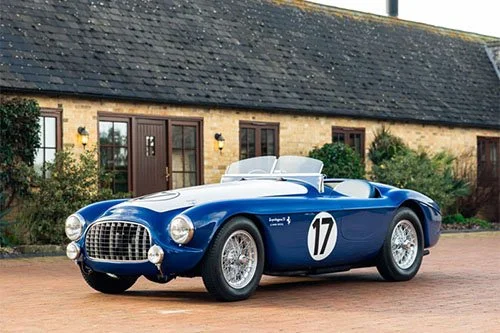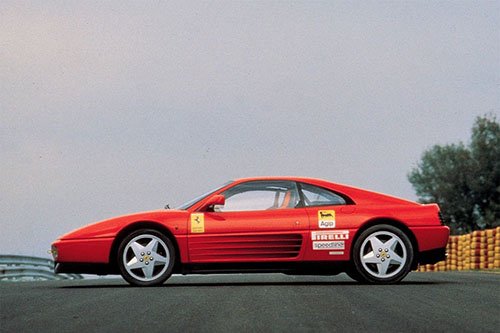Guide: Ferrari Testarossa
Background
At the Paris Motor Show in October 1984, Ferrari publicly unveiled their second generation Flat 12 supercar: the Testarossa.
It replaced the Berlinetta Boxer (BB) that had been produced in three different iterations since late 1973.
Throughout troubled times, the BB had sold reasonably well, but the Testarossa would shift huge volumes and enter the wider public conscience in a manner its predecessor never managed.
Intended to be a faster, better handling, more spacious and more luxurious car than the BB, the Testarossa succeeded on every level. Its styling was also emblematic of the era, which led to many appearances on the big screen, TV and in video games.
Typically pitched as a direct rival to Lamborghini’s Countach, the two cars were actually very different.
Whereas the Countach was outrageous, cramped, noisy and impractical, the Testarossa was quite a refined machine. It had a reliable fuel-injected engine, comparatively light controls and good visibility; conceivably, the Testarossa could be used every day.
Its most recognisable features were the banks of slatted cooling scoops down each flank. Pininfarina were typically more reserved than Lamborghini-stylists, Bertone, but the Testarossa’s outlandish intake ducts filled with multiple vanes gave the car an iconic and unmistakable profile.
Another factor in the Testarossa’s huge commercial success was that it became the first twelve cylinder Ferrari since late 1973 that was officially legal for sale in the US. Previously, the BB had been outlawed on safety and emissions grounds, but the Testarossa was fully US compliant and took America by storm.
It joined a Ferrari line up that comprised the four-seat V12-engined 400i (soon to be replaced by the 412i) and the 288 GTO homologation special which ran a twin turbocharged V8.
There was also the normally aspirated 308 (available as a GTB or targa-topped GTS) and the Mondial (which could be specified as a Coupe or Cabriolet). Within twelve months, the Quattrovalvole-badged 308 and Mondial were replaced by the 328 and Mondial 3.2 respectively.
Chassis
The new car was built on a welded tubular steel chassis with type number F110 AB.
Compared to the BB, the wheelbase was stretched from 2500mm to 2550mm in order to free up a little more cockpit space. There was also a removable engine subframe that could be unbolted from the main chassis for easy maintenance.
Suspension was independent all round via unequal length wishbones, coil springs, telescopic shocks and anti-roll bars. Like the BB, twin shocks were installed each side at the back.
Ventilated disc brakes had a 315mm diameter at the front and 310mm diameter at the rear. ABS was never fitted.
New five-spoke magnesium alloy wheels were fastened in position with a single centre locking nut. They were designed for Michelin’s metric-sized TRX low profile tyres and had a diameter of 415mm (16.33-inches). The fronts were 210mm wide (8.26-inches) and the backs were 240mm wide (9.44-inches).
Compared to the outgoing 512i BB, track was 18mm wider at the front and 97mm wider at the rear.
Twin fuel tanks with an overall capacity of 120-litres were mounted underneath the engine, up against the rear bulkhead.
Engine / Gearbox
Engine-wise, a further uprated version of the familiar 180° Flat 12 DOHC motor was installed.
As before, it was dry-sumped and displaced 4942cc thanks to a bore and stroke of 82mm and 78mm respectively.
However, there were several new features, most notably four-valve cylinder heads and Marelli Microplex MED 120A electronic ignition.
Additionally, the two belt-driven overhead camshafts for each cylinder bank now ran off the crankshaft as opposed to the idler gears.
In standard European specification, the Testarossa’s all-alloy Tipo F113 A engine had no catalytic converters. It used Bosch K-Jetronic fuel-injection and a 9.2:1 compression ratio.
Peak output was 390bhp at 6300rpm and 354lb-ft at 4500rpm.
This compared to 340bhp at 6000rpm and 333lb-ft at 4200rpm for the 512i BB.
Transmission was via a five-speed manual gearbox, twin-plate hydraulic clutch and limited-slip differential.
Bodywork
As usual, Pininfarina were commissioned to design the bodywork and interior for this latest Ferrari.
They ditched the BB’s wedge profile in favour of softer, more modern lines and created one of the most recognisable automobiles ever made.
Most startling were the huge cooling scoops carved out from each flank. These fed the side-mounted water radiators and were enhanced with elaborate horizontal slats.
The slatted theme continued on the tail fascia where a full width black grille was installed that partially obscured the lights. Pininfarina dropped the traditional circular tail lenses that had so long been a Ferrari fixture. They were replaced with modern rectangular clusters.
Retractable headlights were retained at the front and the supplementary lenses were now mounted in the nose fascia alongside a black egg crate grille.
The chin spoiler and side sills were finished matt black to lend the car a more slender profile.
One of the most curious features was a single driver’s side wing mirror positioned towards the top of the A-pillar. It was fitted as the result of a misinterpretation of new laws regarding 100% rearward visibility.
Steel was used for the cabin and doors with plastic for the front and rear bumpers and aluminium for pretty much everything else.
Overall, the Testarossa was 75mm longer, 146mm wider and 10mm taller than the outgoing 512i BB.
Interior
More spacious, better equipped and more luxurious than the BB, the Testarossa’s cockpit was completely redesigned.
The dash, seats, door trim, instrumentation and switchgear were all new, but still quintessentially Italian.
Air-conditioning, leather upholstery, electric windows, electric mirrors and a stereo were standard.
Unless an all-black interior was specified, the leather used for the dash, transmission tunnel and armrests / door handles normally contrasted with the rest of the upholstery.
There was a small amount of storage space behind the seats, but relocating the water radiators to the sides of the car meant there was dramatically more room underneath the front lid. Limited luggage space had been one of the key criticisms of the BB.
Directly behind the leather-rimmed three-spoke steering wheel was the primary instrument binnacle. This housed large read outs for road and engine speed with smaller gauges for oil pressure and water temperature stacked one above the other.
In the centre of the dash, the audio system was concealed underneath a flip up cover.
The control panel that linked the dash with the transmission tunnel was home to a fuel gauge, oil temperature gauge and the odometer.
Most of the switchgear was housed on the centre console behind the open gate gear lever.
Orange on black read outs replaced the traditional white on black.
Options
Aside from a choice of interior and exterior colours, the only optional extra was a six-piece set of Schedoni luggage.
Weight / Performance
The Testarossa weighed 1506kg which was a 7kg gain on the outgoing 512i BB.
It had a top speed of 181mph and 0-62mph time of 5.2 seconds.
Launch
First shown to a select group of Ferrari dealers in Modena during September 1984, the Testarossa was then given a lavish presentation at the Lido Club on the Champs Elysees before making its public debut a day later at the Paris Motor Show.
USA Version
Testarossas destined for the US and Japan came with a special Tipo F113 A 040 engine equipped with catalytic converters and Bosch KE-Jetronic fuel-injection (instead of plain K-Jetronic).
A different exhaust was also installed along with an anti-evaporative emission control system, a secondary air pump and slightly different gearbox.
Peak power of these units was a little lower: 380bhp at 5750rpm.
US cars also came with a host of other modifications to include rectangular side lights, all amber upper lights in the nose, an additional rubber bumper at the back, safety fuel tanks and slightly different instrumentation.
Switzerland / Sweden Version
There was a Tipo F113 A 046 motor for those cars headed to Switzerland and Sweden.
These engines did not have catalytic converters, but did come with the Bosch KE-Jetronic as fitted to US-spec. examples.
Testarossa Spider
In 1986, one Testarossa (chassis 62897) was built as a Spider and presented as a gift to Fiat Chairman, Gianni Agnelli.
Pininfarina reinforced the chassis, fitted a cut-down windscreen, a fully retractable roof and a new engine cover.
As Agnelli had suffered a leg injury in a car accident many years previously, he struggled to depress a conventional clutch.
62897 was therefore equipped with a special Valeo gearbox that had a full automatic mode. When the Valeo button was depressed, the clutch retracted and the car shifted gears automatically.
62897 was painted silver with a blue coachline and blue leather interior.
It also came with a solid silver nose badge and twin wing mirrors.
Miami Vice
Ferrari famously donated two US-spec. 1986 Testarossas to Universal Television for use in the popular American crime drama, Miami Vice.
The show had originally featured a black replica 365 GTS/4 as the main vehicle of leading man, Sonny Crocket (Don Johnson). However, Ferrari were unhappy with the presence of a replica in such a high profile show and supplied a pair of metallic black over cream Testarossas with the single mirror (chassis 63259 and 63631).
To make them more visible when filming at night, both cars were repainted white in the US.
They starred from mid way through the 1986 season until the show’s demise in 1989.
Production Changes
During production, a number of changes were made.
At the Geneva Motor Show in March 1986, Ferrari unveiled an updated variant.
Twin mirrors were fitted at the base of each A-pillar and the wheels were changed to imperial instead of metric dimensions. They were still the same centre locking design, but now measured 16 x 8-inches at the front and 16 x 10-inches at the rear.
At the same time, the engines in European market cars were switched from Tipo F113 A to F113 B to denote they now ran the Bosch KE-Jetronic fuel-injection. New Marelli MED 120B electronic ignition was also installed.
Swiss and Swedish market examples switched from Tipo F113 A 046 to the Tipo F113 B 046 motor. They had always used KE-Jetronic, but now came with catalytic converters and Marelli 120B/D ignition.
US and Japanese Testarossas also got the Marelli 120B/D ignition. Additionally, those cars destined for America received a third brake light located on the body coloured centre section of the engine cover.
From 1987, US market cars came with a new Passive Restraint System. It comprised an extra safety belt for each seat that electronically travelled up the A-pillar and along the roofline until it was behind the occupant’s shoulder. A padded shelf was also added underneath the dash.
June 1988 saw the single nut wheels replaced by a new five-bolt design. These were manufactured by both OZ and Speedline and led to slightly wider track (2mm extra at the front and 17mm at the rear).
Soon afterwards, some very subtle updates were made to the seats and mirrors.
From 1989 (at chassis 82967), catalytic converters became standard on all Testarossas.
Aside from some very minor updates, the specification thereafter remained unchanged.
End of Production
Production ended in early 1992 when the Testarossa was replaced by the 512 TR.
By this time, 7177 Testarossas had been built of which 438 were right-hand drive.
Testarossa Pininfarina Speciale
Included in this figure were eleven Spider conversions executed by Pininfarina. All of these were right-hand drive commissions for the Sultan of Brunei.
The Turin studio also designed a special-bodied Testarossa called the F90 for the same client.
Additionally, the Brunei royal family ordered Pininfarina to build several replicas of the Testarossa-based Mythos concept. The precise number of F90 and Mythos built is unknown, but cars were typically ordered in batches of at least three units.
Text copyright: Supercar Nostalgia
Photo copyright: Ferrari - https://www.ferrari.com


